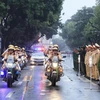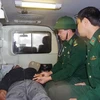Geneva (VNA) – A collection of nearly 70 photos taken by Swiss physician and bacteriologist Alexandre Yersin are placed on display at an exhibition in Morges, Switzerland to commemorate the 75th anniversary of his death (1943-2018).
The exhibition is co-organised by the Association of Admirers of Alexandre Yersin and the Embassy of Vietnam in Switzerland, featuring photos taken by the doctor during his stay in Indochina from 1892-1941.
The photos were restored from their original versions kept at Pasteur Museum in the French capital Paris, the Yersin Museum in Nha Trang in central coast of Vietnam, and as well as those looked after by his family.
They captured his house and garden in Con village, Nha Trang and his memories travelling around the Lang Biang Highlands, Saigon, Cambodia, and more. The photographs portrayed local people, and especially the fishing community, of Con village, as well as various ethnic minority people around Vietnam.
According to the Vietnamese Ambassador to Switzerland, the event offers viewers new insight into Yersin’s life and the beauty of Vietnam’s natural landscapes and people, while also contributing to strengthening the relations between Vietnam and Switzerland.
Association President Jacques-Henri Penseyres praised Yersin as an inspiring humanitarian with a passion for science and great courage to pursue an adventurous life. He added that the association first came up with the idea of collecting photos by doctor Yersin two years ago.
The exhibition will run through until November 18.
Yersin, the Swiss doctor who became a French citizen but ultimately lived and died with Vietnam in his heart, is remembered as the co-discoverer of the bacillus responsible for the bubonic plague, which was later named in his honour (Yersinia pestis). This discovery was one of the greatest revelations for humankind in history.
Dr Yersin settled down in the coastal city of Nha Trang in 1891 where he lived for more than 50 years and became Director of the Pasteur Institute in Nha Trang in 1895.
He was credited for finding the site for the town of Da Lat (300km northwest of what was then Saigon) in 1893. He also tried his hand at agriculture and was a pioneer in the cultivation of rubber trees in Vietnam.
Yersin's house in Nha Trang is now the Yersin Museum and the epitaph on his tombstone describes him as a benefactor and humanist, venerated by the Vietnamese people. –VNA
The exhibition is co-organised by the Association of Admirers of Alexandre Yersin and the Embassy of Vietnam in Switzerland, featuring photos taken by the doctor during his stay in Indochina from 1892-1941.
The photos were restored from their original versions kept at Pasteur Museum in the French capital Paris, the Yersin Museum in Nha Trang in central coast of Vietnam, and as well as those looked after by his family.
They captured his house and garden in Con village, Nha Trang and his memories travelling around the Lang Biang Highlands, Saigon, Cambodia, and more. The photographs portrayed local people, and especially the fishing community, of Con village, as well as various ethnic minority people around Vietnam.
According to the Vietnamese Ambassador to Switzerland, the event offers viewers new insight into Yersin’s life and the beauty of Vietnam’s natural landscapes and people, while also contributing to strengthening the relations between Vietnam and Switzerland.
Association President Jacques-Henri Penseyres praised Yersin as an inspiring humanitarian with a passion for science and great courage to pursue an adventurous life. He added that the association first came up with the idea of collecting photos by doctor Yersin two years ago.
The exhibition will run through until November 18.
Yersin, the Swiss doctor who became a French citizen but ultimately lived and died with Vietnam in his heart, is remembered as the co-discoverer of the bacillus responsible for the bubonic plague, which was later named in his honour (Yersinia pestis). This discovery was one of the greatest revelations for humankind in history.
Dr Yersin settled down in the coastal city of Nha Trang in 1891 where he lived for more than 50 years and became Director of the Pasteur Institute in Nha Trang in 1895.
He was credited for finding the site for the town of Da Lat (300km northwest of what was then Saigon) in 1893. He also tried his hand at agriculture and was a pioneer in the cultivation of rubber trees in Vietnam.
Yersin's house in Nha Trang is now the Yersin Museum and the epitaph on his tombstone describes him as a benefactor and humanist, venerated by the Vietnamese people. –VNA
VNA






















